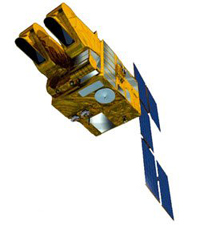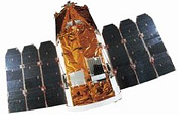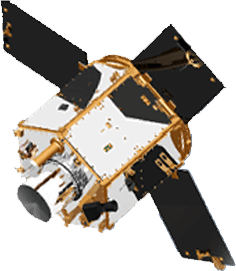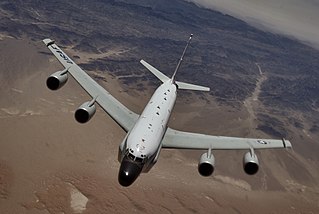Related Research Articles

The Guiana Space Centre, also called Europe's Spaceport, is an European spaceport to the northwest of Kourou in French Guiana, a overseas territory of France in South America. In operation since 1968, it is suitable as a location for a spaceport, because of its equatorial location and open sea to the east.

The National Centre for Space Studies is the French government space agency. Its headquarters are located in central Paris and it is under the supervision of the French Ministries of Defence and Research.

SPOT is a commercial high-resolution optical Earth imaging satellite system operating from space. It is run by Spot Image, based in Toulouse, France. It was initiated by the CNES in the 1970s and was developed in association with the SSTC and the Swedish National Space Board (SNSB). It has been designed to improve the knowledge and management of the Earth by exploring the Earth's resources, detecting and forecasting phenomena involving climatology and oceanography, and monitoring human activities and natural phenomena. The SPOT system includes a series of satellites and ground control resources for satellite control and programming, image production, and distribution. Earlier satellites were launched using the European Space Agency's Ariane 2, 3, and 4 rockets, while SPOT 6 and SPOT 7 were launched by the Indian PSLV.

Spot Image, a public limited company created in 1982 by the French Space Agency, Centre National d'Etudes Spatiales (CNES), the IGN, and Space Manufacturers is a subsidiary of Airbus Defence and Space (99%). The company is the commercial operator for the SPOT Earth observation satellites.

Satellite images are images of Earth collected by imaging satellites operated by governments and businesses around the world. Satellite imaging companies sell images by licensing them to governments and businesses such as Apple Maps and Google Maps.
The Helios 2 system includes Helios 2A and Helios 2B, both of which are European military observation satellites used by France, Belgium, Spain and Greece. Helios 2A was launched on December 18, 2004 by an Ariane 5 rocket from French Guiana. Helios 2B was launched five years later on December 18, 2009, carried also by an Ariane 5. The two satellites are identical. They carry a Thales-built high-resolution visible and thermal infrared instrument with 35 cm resolution, and an Airbus-built medium-resolution instrument.

Earth Resources Observation Satellite (EROS) is a series of Israeli commercial Earth observation satellites, designed and manufactured by Israel Aircraft Industries (IAI), with optical payload supplied by El-Op. The satellites are owned and operated by ImageSat International (ISI), another Israeli company, with some 35 full-time employees. EROS A was launched on December 5, 2000 and EROS B on April 25, 2006.

SAR-Lupe is Germany's first reconnaissance satellite system and is used for military purposes. SAR is an abbreviation for synthetic-aperture radar, and "Lupe" is German for magnifying glass. The SAR-Lupe program consists of five identical (770 kg) satellites, developed by the German aeronautics company OHB-System, which are controlled by a ground station responsible for controlling the system and analysing the retrieved data. A large data archive of images will be kept in a former Cold War bunker belonging to the Kommando Strategische Aufklärung of the Bundeswehr. The total price of the satellites was over 250 million euros.
Cartosat-2 is an Earth observation satellite in a Sun-synchronous orbit and the second of the Cartosat series of satellites. The satellite was built, launched and maintained by the Indian Space Research Organisation (ISRO). Weighing around 680 kg at launch, its applications will mainly be towards cartography in India. It was launched by the Polar Satellite Launch Vehicle PSLV-C7 launch vehicle on 10 January 2007.

RazakSAT is a Malaysian Earth observation satellite carrying a high-resolution camera. It was launched into low Earth orbit on 14 July 2009. It was placed into a near-equatorial orbit that presents many imaging opportunities for the equatorial region. It weighs over three times as much as TiungSAT-1 and carries a high resolution Earth observation camera. Developed in conjunction with Satrec Initiative, the satellite's low inclination orbit brought it over Malaysia a dozen or more times per day. This was intended to provide greatly increased coverage of Malaysia, compared to most other Earth observation satellites. An audit report released in October 2011 revealed that the satellite had failed after only 1 year of operation.

Signals intelligence operational platforms are employed by nations to collect signals intelligence, which is intelligence-gathering by interception of signals, whether between people or between machines, or mixtures of the two. As sensitive information is often encrypted, signals intelligence often involves the use of cryptanalysis. However, traffic analysis—the study of who is signalling whom and in what quantity—can often produce valuable information, even when the messages themselves cannot be decrypted.
KOMPSAT-2, also known as Arirang-2, is a South Korean multipurpose Earth observation satellite. It was launched from Plesetsk Cosmodrome, Russia at 07:45:43 UTC on 28 July 2006. It began to transmit signals at 14:00 UTC the same day. Like the earlier KOMPSAT-1 satellite, it takes its name from the popular Korean folk song Arirang. Its launch was the culmination of a project begun in 1995.

The Pléiades constellation is composed of two very-high-resolution optical Earth-imaging satellites. Pléiades-1A and Pléiades-1B provide the coverage of Earth's surface with a repeat cycle of 26 days. Designed as a dual civil/military system, Pléiades will meet the space imagery requirements of European defence as well as civil and commercial needs.
The MUltinational Space-based Imaging System for Surveillance, Reconnaissance and Observation (MUSIS) is an international program including France, Italy, Belgium, Germany, Greece, and Spain, aimed at allowing the six nations to share imagery from various military satellites through a common, generic user ground segment (UGS) according to agreed rules and quota.
The Earth Remote Observation System-A was part of the EROS family of Israeli commercial Earth observation satellites, designed and manufactured by Israel Aircraft Industries (IAI). This was the first satellite in the series. The satellite was owned and operated by ImageSat International, ImageSat International N.V. (ISI) headquartered at Limassol, Cyprus, and incorporated in the Netherlands Antilles, Cayman Islands.
ELISA is a suite of four French military satellites launched on 17 December 2011 from Arianespace's Kourou spaceport in French Guiana. It consists of microsatellites ELISA 1, ELISA 2, ELISA 3, and ELISA 4
SEOSat-Ingenio, was a Spanish project to produce a satellite capable of providing wide-field imagery ensuring a repeat cycle of 38 days at 2.5 metre panchromatic resolution and 10 metre colour resolution, from a sun-synchronous polar orbit; it was Spain's first optical imaging satellite. The satellite was part of the Spanish Earth Observation Satellite program. The mission was funded by Spain's Centre for the Development of Industrial Technology (CDTI). SEOSat-Ingenio information was to be used by various Spanish civil, institutional or government users. However, under the Copernicus Programme of the European Union, it was also accessible to other European users, as well as to the Group on Earth observation of the Global Observing System of Earth.
Sodern is a French company based in Limeil-Brévannes, near Paris in Ile-de-France, specialized in space instrumentation, optics and neutron analyzers.

Vegetation and Environment monitoring on a New Micro-Satellite (VENµS) is a near polar sun-synchronous orbit microsatellite. It is a joint project of the Israeli Space Agency and CNES. The project was signed upon in April 2005 and was launched on the 2nd of August 2017. The microsatellite, which was set to cost the ISA US$20 million and CNES €10 million, was designed and built by IAI and Rafael under ISA's supervision.

The French Space Command is a formation of the French Air and Space Force, which deals with space issues. It supersedes the Joint Space Command, which was created in 2010.
References
- 1 2 (in French) French Finance Law for 2013 : Defence : Equipment
- 1 2 (in French) Opex360.com article
- ↑ SpaceNews article
- 1 2 (in French) Hearing of the French Space Command Chief by the National Assembly
- ↑ "CSO-1 L'ESPACE AU SERVICE DE LA DÉFENSE". CNES. 7 February 2019. Retrieved 11 October 2020.(in French)
- 1 2 page on CSO on the CNES website
- ↑ (in French) Hearing on the Director of Military Intelligence at the French National Assembly
- ↑ SpaceNews article on Helios II B
- ↑ (in French) French Military Planning Law for 2014-2019
- ↑ Lagneau, Laurent (4 March 2022). "Faute de lanceur Soyouz, la mise sur orbite du satellite militaire français CSO-3 sera retardée d'un an" [In the absence of a Soyuz launcher, the orbital insertion of the French military satellite CSO-3 will be delayed by a year]. Opex360 (in French). Retrieved 7 March 2022.
- ↑ (in French) Article on Musis on the French Ministry of Defense website
- ↑ Sofradir wins military satellite IR detector contract
- ↑ "Lancement de la réalisation des satellites CSO du programme Musis". Direction générale de l'armement. 28 June 2010. Retrieved 13 November 2013.(in French)
- ↑ (in French) Article mentioning Pléiades programming rights
- ↑ (in French) Press release from the DGA